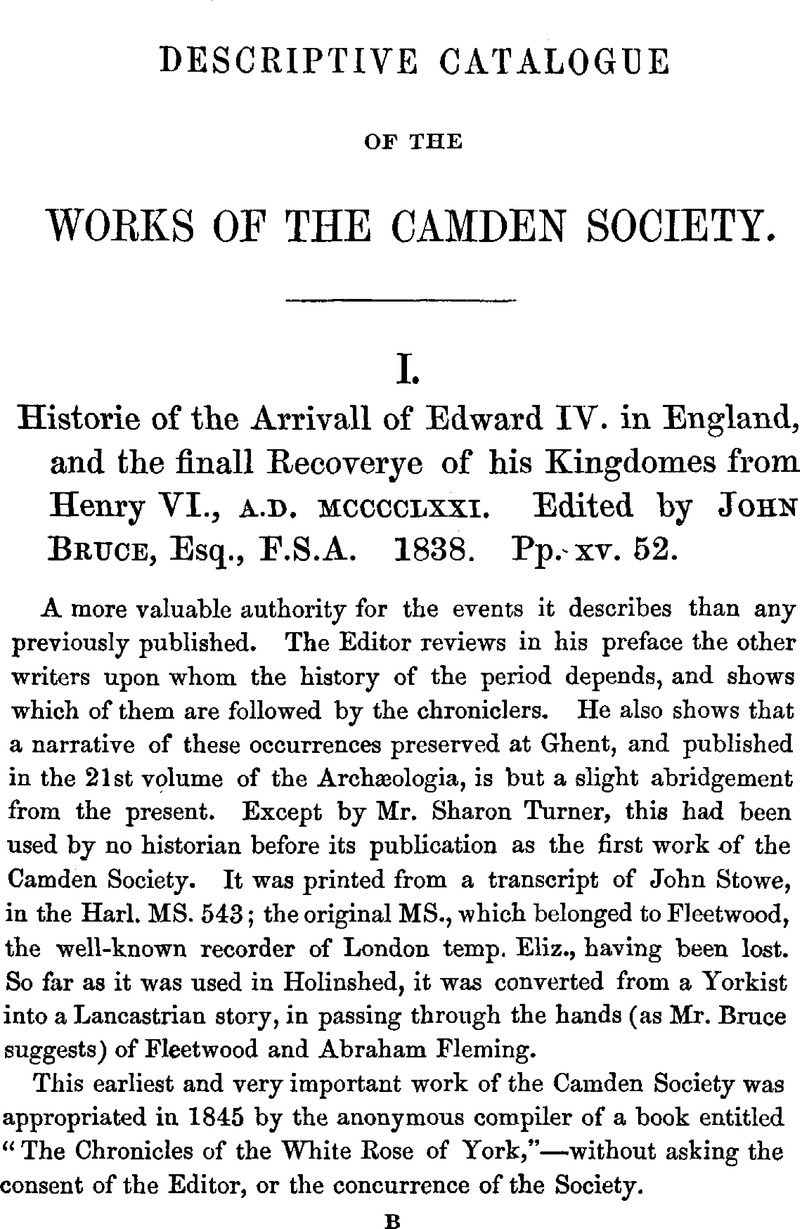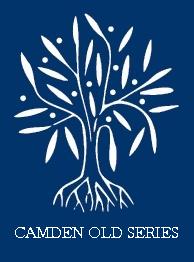No CrossRef data available.
Article contents
Descriptive Catalogue of the Works of the Camden Society
Published online by Cambridge University Press: 10 November 2010
Abstract

- Type
- Other
- Information
- Camden Old Series , Volume 106: A Descriptive Catalogue of the First Series of the Works of the Camden Society , December 1872 , pp. 1 - 86
- Copyright
- Copyright © Royal Historical Society 1872
References
page 2 note † Mr. Wright has been the editor of two impressions of the “Visions of Piers Plowman,” published in 1842 and 1856.
page 4 note * Some further particulars of this MS. work will be found at p. 113 of the “Memoir of John Aubrey, F.R.S.” by John Britton, F.S.A. 1845, 4to. published by the Wiltshire Topographical Society.
page 10 note * “As no piece of that kind is extant, we are unable to ascertain its nature with precision; but it appears to have been a ludicrous metrical composition, either spoken or sung by the Clown, and occasionally accompanied by dancing and playing on the pipe and tabor.” Introduction, p. xx.
page 10 note † The proverbial expression of a Nine Days' Wonder is traced back more than half a century before Kemp's performance: see Notes and Queries, Second Series, xi. 249, 297, 478. It was scarcely applied with strict truth to Kemp's journey, for his nine days of dancing were not consecutive, and, including his intervening rests (one of which was for five days at Bury), it occupied altogether twenty-four days.
page 12 note * An episode, being an account of the duel fought in 1163 between Henry of Essex and Robert de Montford, the former of whom, being accused of treason whilst acting as the King's standard-bearer in Wales, was vanquished, and became a monk of Reading, is written by a different hand, and in a more ambitious style.
page 13 note * Mr. Halliwell inadvertently states in p. v. that Rishanger was appointed historiographer to King Henry II. in 1259; but, immediately after, he shows by an autograph memorandum of Rishanger himself (of which a lithographic facsimile accompanies this volume), that he was only sixty-two in 1342.
page 15 note * See the Thornton Romances (Camden Society, 1844), p. xxix.
page 15 note † The dialect of the South Eastern district is well known by Tim Bobbin's works.
page 18 note * Other papers relating to this memorable meeting are printed in the Archæologia, vol. xxi. 175; and in the Chronicle of Calais. (Camden Society, No. XXXV.)
page 19 note * Some notes on his personal history are given in Notes and Queries, I. x. 161.
page 29 note * If Sir Henry Ellis's estimate of the language be admitted, the spelling is execrable. To conciliate the taste of the general reader, the orthography should be modernized.
page 30 note * Mr. Holmes had previously published, in the Gentleman's Magazine for 1840, a Catalogue of the French Ambassadors to England. These and other similar collections by Mr. Holmes (considerably enlarged by his MS. additions) are now preserved among the Additional MSS. in the British Museum.
page 34 note * A later Diary of the same writer, from 1642 to 1645, is now preserved in the British Museum, Addit. MSS. 18,777–18,780.
page 34 note † After a remarkable practice, Machyn dated his birthday by the Wednesday in Whitsun week, so that it was with him a “moveable feast.” I did not detect this circumstance before the book was published.
page 36 note * For Sir Roger Twysden's Journal see the third volume of Archæologia Cantiana, 1861.
page 41 note * Sir Richard Guylford (who was a Knight of the Garter,) died at Jerusalem, Sept. 6, 1506, the day after his principal comrade, John Whitby, Prior of Gisborough in Yorkshire.
page 41 note † The Pilgrimage of Richard Torkington, Parson of Mulberton in Norfolk, is a small MS. volume formerly in the possession of Mr. R. B. Wheler of Stratford upon Avon. Considerable extracts from it were published in the Gentleman's Magazine for October 1812, and they are reprinted in Fosbroke's British Monachism. Those which are added in the Magazine for Jan. 1852 exhaust all his most remarkable passages. Torkington's Pilgrimage and that of William Wey were both for some time on the list of Suggested Works of the Camden Society. The latter has been subsequently printed for the Roxburghe Club, 1857.
page 41 note ‡ As shown by the names of places being generally in the Latin genitive case.
page 43 note * One of the most curious passages extracted by Stowe from this Chronicle, that relating to the execution of Agnes lady Hungerford (there erroneously called Alice), for the alleged murder of her husband, has been further illustrated—though not entirely cleared of its mystery, by an article in the XXXVIIIth volume of the Archæologia, entitled, “An Inventory of the Goods of Dame Agnes Hungerford,” &c.
page 45 note * By milk sent forth from her breasts Nature is revivifying the body of a man cut into pieces; with this motto—Cuncta fovens lapsa instauro, peritura deduco. The noble Editor apparently did not perceive the meaning of this design, remarking in his Introduction that “the subject has completely baffled me, though I have sought for it in all the works on Emblems, &c. to which I could procure access.”
page 47 note * Mr. Bruce has established (p. 31,) the marriage of Sir Ralph with Eleanor sister to Sir Richard Pole, K.G., the father of Cardinal Pole and his brethren, by Margaret (of Clarence) Countess of Salisbury. He has inadvertently styled Geoffrey Pole, the father of Sir Richard and Eleanor, “Sir Geoffrey Pole, K.G.” He was plain “Geoffrey Pole, of Buckinghamshire.” (Collectanea Topogr. et Geneal. i. 130.)
Mr. Brue has also (at p. 47) identified as Sir Ralph Verney's a tomb at King's Langley which had been traditionally reported to be that of Piers Gaveston.
page 51 note * In Mr. Gairdner's preface to “Letters and Papers illustrative of the Reigns of Richard III. and Henry VII.” 1861, p. xviii. it is alleged that I have misunderstood this important incident of Richard's usurpation: for “the parliament really did meet, but the meeting was an informal one” Mr. Gairdner refers to the gathering at Baynard's Castle, on the 25th of June, the very day that had been appointed for the parliament at Westminster. I do not, however, perceive that such meeting lasted beyond the day, or can be maintained to have amounted to a parliament. J. G. N.
page 51 note † A brief political sermon (in English), preached by the bishop of Exeter at St. Paul's on the accession of Edward IV. in 1461, is edited by Mr. Halliwell in the Archæologia, vol. xxix. p. 128, from the Cottonian MS. Vespasian E. VII.
page 55 note * On the history of the Brut Chronicle there is an interesting paper by Sir Frederic Madden commencing the Second Series of Notes and Queries in 1856.
page 55 note † Now edited by Frank Scott Haydon, Esq. B.A., under the direction of the Master of the Rolls.
page 62 note * Three sets of English miracle-plays have been published: that of Widkirk, under the title of the Towneley Mysteries, by the Surtees Society in 1836; those of Coventry and Chester by the Shakespeare Society in 1841 and 1843–7. Mr. Edward Towneley had, still earlier, in 1822, presented to the Roxburghe Club “Judicium, a Pageant. Extracted from the Towneley MS. of Ancient Mysteries.” The first publication of the Abbotsford Club was “Ancient Mysteries,” from the Digby MS. 1835; and its second “The Weavers' Pageant,” 1836.
page 70 note * This subject has been pursued in the Herald and Genealogist, vol. i. pp. 159–174.
page 76 note * One of the Society's earlier works, the Diary of John Rous (No. LXVL), exhibits many manifestations of this popular sentiment.
page 83 note * A photographic fac-simile of a page at this place appears in the frontispiece.


